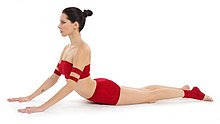Bhujangasana

Bhujangasana (/ˈbuː.dʒænˈɡɑː.sɑː.nɑː/;[1] Sanskrit: भुजङ्गासन; IAST: Bhujaṅgāsana) or Cobra Pose[2] is an asana.
Etymology
The name comes from the Sanskrit words bhujanga meaning "snake" or "serpent" and asana (आसन) meaning "posture" or "seat".
Description
From a prone position with palms and legs on the floor, the chest is lifted.
Benefits
Bhujangasana may strengthen the spine, stretch the chest, shoulders, and abdomen, firm the buttocks, and relieve stress and fatigue. Traditional texts say that Bhujangasana increases body heat, destroys disease, and awakens kundalini.
Cautions
Common postural errors during this asana include overarching the neck and lower back. One recommendation is to keep the gaze directed down at the floor and focus on bringing movement into the area between the shoulder blades (the thoracic area, or middle back).[3]
Follow-up asanas
Bhujangasana is often followed by Salabhasana. In Surya Namaskar, it precedes Adho Mukha Svanasana.
See also
References
- ^ Budilovsky, Joan; Adamson, Eve (2000). The complete idiot's guide to yoga (2 ed.). Penguin. p. 156. ISBN 978-0-02-863970-3. Retrieved 11 April 2011.
- ^ "Yoga Journal – Cobra Pose". Retrieved 2011-04-09.
- ^ Yoga for Chronic Pain, Part I, By Timothy McCall, M.D.
- General
- Lasater, Judith Hanson (July–August 2005). "Instant yoga: Cobra Pose (Bhujangasana)". Natural Health. 35 (7): 24.
- Wilson, RL (February 1976). "An introduction to Yoga". American Journal of Nursing. 76 (2): 261–3. doi:10.2307/3423818. JSTOR 3423818. PMID 1044224.
Further reading
- Iyengar, B. K. S. (1 October 2005). Illustrated Light On Yoga. HarperCollins. ISBN 978-81-7223-606-9. Retrieved 9 April 2011.
- Saraswati, Swami Satyananda (1 August 2003). Asana Pranayama Mudra Bandha. Nesma Books India. ISBN 978-81-86336-14-4. Retrieved 9 April 2011.
- Saraswati, Swami Satyananda (January 2004). A Systematic Course in the Ancient Tantric Techniques of Yoga and Kriya. Nesma Books India. ISBN 978-81-85787-08-4. Retrieved 9 April 2011.
External links
- Cobra Pose Video and Step by Step Instruction]
- Pizer, Ann. "Cobra Pose – Bhujangasana". Yoga. About.com. Archived from the original on 3 March 2007. Retrieved 14 February 2007.
{{cite web}}: Unknown parameter|deadurl=ignored (|url-status=suggested) (help)

